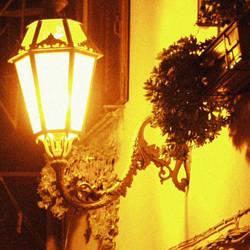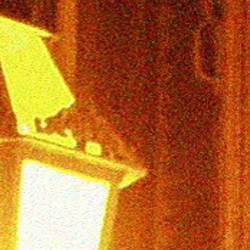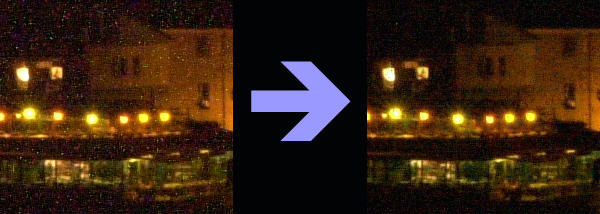 DarClean
DarClean
How to get rid of digital noise
by Diego Meozzi
The magic of digital photography: just point, shoot and review immediately the results on a color monitor. Is the photo a blooper? Just erase it from your camera's memory and shoot another one!
Digital photography has many advantages over traditional film photography, but, of course, it is far from perfect. If you have ever tried to make a photo at night without flash, using an exposure time higher than 1/15 sec, you have almost certainly faced one of the limits of digital technology. That image would always be grainy and, when enlarged, show thousands of tiny colored specks.
 |
A streetlight shot with an Olympus Camedia C-2500L. Exposure time: 1/6 sec with a 28mm at f/3.9. Sensitibity set at ISO 400. On the right, the 5x enlargement shows the noise on the image |
 |
What the %$@# is this? Well, you have just found out what digital noise looks like. That noise (the grain and/or the colored specks) limits the quality of digital images shot with high exposure times more than anything else. There are many sources of digital noise:
- Photon noise
The number of photons that reach the CCD (the imaging chip) of your camera while you are making an exposure - Thermal noise
Self-generated by the photosites (the light-sensing elements) in the CCD chip: the warmer the temperature, the greater the noise - Readout noise
Due to the inability of the CCD control components to determine precisely how many electrons have come from each photosite - Quantization
noise
Caused by the processing of output data from the CCD chip and their division into "steps" (a 16-bit camera divides the signal into 65,536 steps) - Sensitivity
variation noise
Modern CCDs are uniform to better than 10% over the surface of the chip
Fortunately, the vast majority of these sources of noise are negligible for ordinary digital photography, as they are important only when you are making photos of astronomical subjects: galaxies, planets, nebulae. The only really nasty noise source is the one called thermal noise.
Wonder how to improve a digital photo from this...

...To this? Just read on!
|
| visits since 25th August 2000 |
| | |